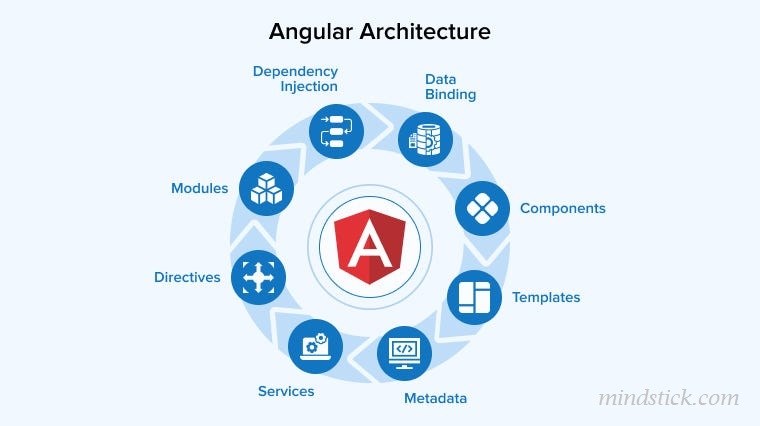Angularjs is a JavaScript-based open-source front-end web framework used to build dynamic
single-page applications (SPA). It follows the model-view-controller (MVC) architecture, although it is more accurately described as
MVVM (Model-View-ViewModel) or MVW (Model-View-Whatever) due to its flexibility.
Key Components of AngularJS Architecture
There are some components of angularjs architecture are as follow,
Model:
- The model is the data source of the application.
- It represents the data and logic of the application.
- Angularjs supports two-way data binding, so when the model changes, the view reflects the change and vice versa.
View:
- The view is the HTML markup where AngularJS expressions and directives are used.
- It displays data from the model to the user and reacts to user interactions.
- AngularJS extends HTML with custom directives, such as
ng-model,ng-bind,ng-repeat, etc.
Controller
- The controller is a JavaScript function that manages scope and business logic.
- It initializes the model and handles user input.
- It is connected to the view through the
$scopeobject.
Scope
- An object that connects the controller and the view.
- Acts as a glue between the model and the view.
- Any change in the scope is automatically reflected in the view (due to two-way data binding).
Directives
- Special tokens (HTML attributes) in markup that tell Angularjs to do something with a DOM element.
- Examples:
ng-model,ng-bind,ng-if,ng-repeat. - You can also create custom directives for reusability.
Expressions
- Expressions are used to bind data to HTML.
- Written inside
{{ }}and behave like JavaScript expressions. - Automatically updated when the scope data changes.
Filter
- Used to format data before showing it to the user.
- Example:
currency,date,filter,lowercase,uppercase.
Services
- Reusable business logic or functions that can be injected into controllers, directives, filters, etc.
- Example:
$http,$location,$timeout.
Dependency Injection (DI)
- A design pattern used to inject dependencies such as services into controllers or other components.
- Promotes modularity and testability.
Routing (ngRoute / UI-Router)
- Used to create single-page applications with multiple views.
- Maps URLs to templates and controllers.
- Enables deep-linking and navigation without reloading the page.
AngularJS Flow Overview
- The user interacts with the view (HTML).
- The
viewis bound to ascopeobject. - The
controllerupdates themodelthrough thescope. - AngularJS detects
modelchanges using the digest cycle and updates theviewaccordingly. - Optional
servicesandfilterscan be used for logic and presentation.




Leave Comment